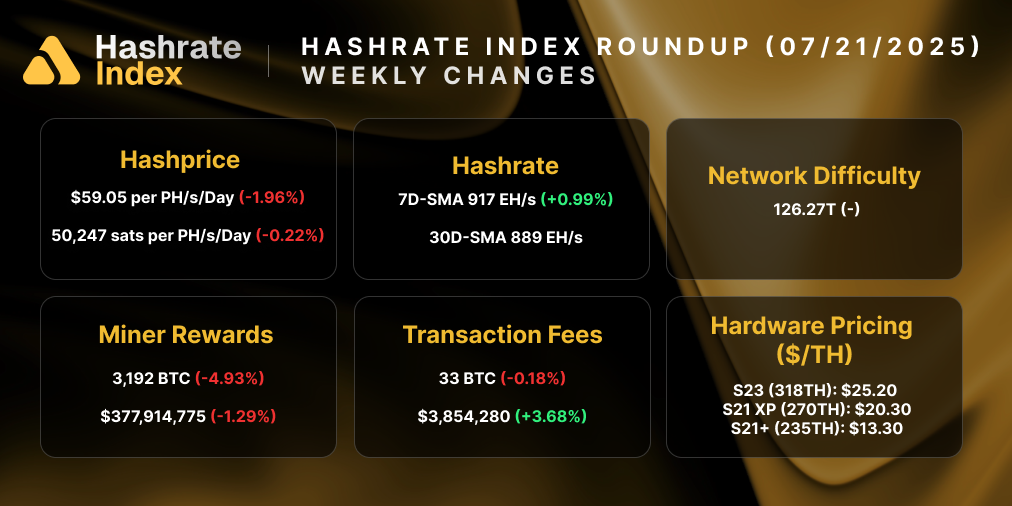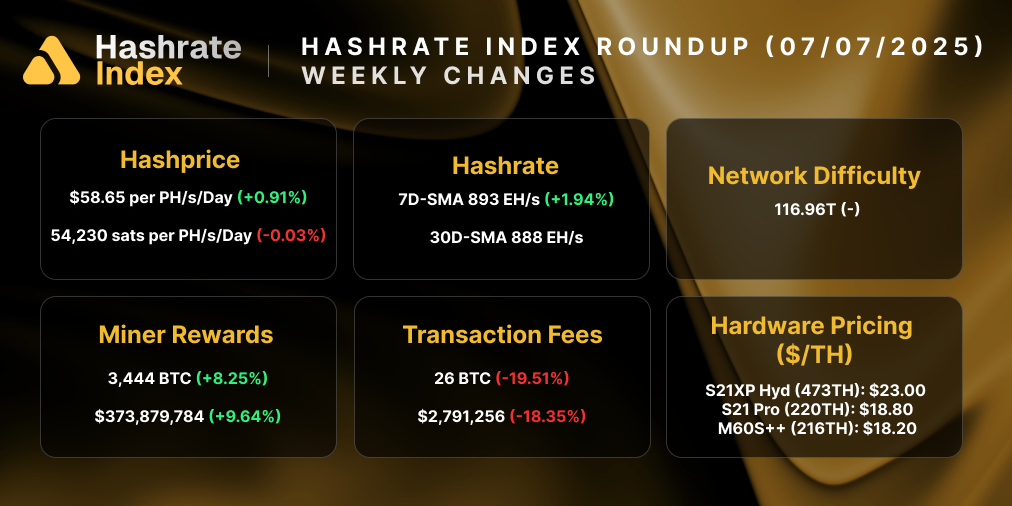
Hashrate Index 2022 Bitcoin Mining Year in Review
2022 is in the books, and we cover the highs (and mostly) lows in our year in review.
Our 2022 Year in Review is here!
2022 was a watershed year for Bicoin mining, mostly for hard-to-stomach reasons. 2021's bull market flushed the Bitcoin mining industry with gobs of capital and new participants. As the industry has become increasingly institutionalized and intertwined with traditional finance and energy sectors, there's never been as much interest in Bitcoin mining, nor has there ever been as much money on the table – and by the same token, there's never been as much to lose.
That's why 2022's bear market hit so hard. Hashprice hit an all-time low in November. New-gen ASICs exited the year at all-time low valuations. Many Bitcoin mining stocks fell more than 90%. North America's leading hosting providers went bankrupt. Acquisitions and asset sales became a prevailing theme. Riches gained in the bull market were lost. And for however tough 2022 was, 2023 could be tougher still.
We cover all of the above – and much more! – in our 70 page year-end report, which you can download below. If you find the report useful, please share and feel free to give us your feedback!
For the remainder of today's newsletter, we've included a teeny sampling of the data and analysis we packed into the report.
Bitcoin's hashrate swims against the current
Even with last year's market carnage, Bitcoin’s hashrate grew 41% in 2022 (compared to 2021’s 18% growth) as if to spite the year’s market carnage. That said, China’s Bitcoin mining ban greatly stunted hashrate growth in 2021, and Bitcoin’s hashrate started to taper downward toward the end of 2022 as the hashprice lows knocked off run-of-the-mill and high-cost operators – not to mention a continental blizzard in the US that put mining farms on the fritz.
With Bitcoin’s price impaired, miners made significantly less on a USD-basis compared to 2021. Still, the $9.55 billion in revenue is still nearly double the rewards miners reaped each year in 2020, 2019, and 2018.
Hashprice hits rock bottom
2022 was like 2021 in reverse, and for miners, no dataset illustrates this better than hashprice.
2021’s bull market – and the hashrate blackout caused by China’s Bitcoin mining ban – made the year an extremely profitable time to mine Bitcoin. The average hashprice for the year was $314.61/PH/day and the yearly high was $412.57/PH/day.
2022 was just the opposite.
The USD hashprice high for 2022 of $246.86/PH/day came on January 1, and it was only downhill from there. The average USD hashprice was $123.88/PH/day, and the $55.94/PH/day low for the year was also an all-time low for Bitcoin’s hashprice. Rises in power costs, which we cover in our chapter on energy, put additional pressure on mining margins.
Bitcoin may be in a bear market, but energy isn't
The average industrial electricity price in the US in 2022 was $85 per MWh, a 16% increase from 2021. Even after this electricity price inflation, 35 states have lower average industrial electricity rates than the S19 Pro’s current break-even electricity price of $92 per MWh.
Bitcoin mining is still very viable in many US states, particularly considering the opportunities for miners to reduce their ultimate electricity prices by engaging in sophisticated power strategies. These power strategies can take many forms, but a common theme is that miners exploit the unique low-consequence-interruptibility of the bitcoin mining process by adjusting their electricity consumption based on market signals. (Other high-energy intensive industries, like traditional data centers or industrial manufacturing, cannot power down without disrupting major economic activities).
In some lucky states, their abundant hydropower and independence from increasingly expensive natural gas has shielded them from the worst electricity price rises. The chart below shows the relationship between states’ shares of hydropower and the changes in their industrial electricity prices in 2022. The inverse correlation of -0.32 signals that the hydro-rich states have seen a significantly lower increase in their electricity prices in 2022 than those with little hydro.
With energy prices surging in 2022, hosting costs ballooned as well.
Before 2022’s energy price inflation, a reasonable hosting contract might offer power prices at $0.05-$0.06/kWh. Now, it’s not uncommon to see $0.08-0.09/kWh, and many hosting contracts are switching from the standard ‘all-in’ hosting terms to profit/revenue sharing models. Anything below $0.075/kWh is considered “a steal” given market conditions.
The chart below looks at average hosting costs on Luxor's Hosting Marketplace and Hashbranch.
ASICs are like really expensive paperweights
2022 put pressure on every aspect of the Bitcoin mining market, and few aspects of the mining market felt this pressure more than the ASIC trade.
In 2021, New-gen (S19, M30 series) and mid-gen rigs (S17, M20 series) hit all-time high values amid the market mania. In 2022, the bear market drove these rig tiers to all-time lows. New-gen rigs fell 85% from $101.04/TH to $14.88/TH, mid-gen rigs fell 87% from $76.10/TH to $9.92/TH, and old-gen rigs fell 82% from $26.53/TH to $4.72/TH.
As the year progressed and mining margins continued to dwindle, the S19 XP premium grew progressively larger throughout the year. Pure-play Bitcoin mining companies are pressured to buy XPs if they have higher operating costs, despite their lower expected investment return. This phenomenon has led to a significant divergence in projected investment return for new generation machines and highlights the advantage of lower-cost miners.
2022 was tough on public miners
As shown in the chart below, most pure-play bitcoin mining stocks fell by 90% or more in 2022. Core Scientific (CORZ) performed the worst, with its stock plummeting by 99%. The company is currently going through a Chapter 11 bankruptcy, which we explain more closely in chapter 6 section 3. The second-worst performer was Greenidge Generation (GREE), a natural-gas power plant operator turned bitcoin miner. Its stock plunged by 98%, as the company struggled under a mountain of high-interest rate machine-collateralized debt.
Driven by market incentives, the public miners expanded as quickly as possible in 2022, mostly with hardware that was pre-ordered in 2021. As you can see on the chart below, public miners started the year producing 14% of Bitcoin’s hashrate, and ended the year at 19%. This increase in their share of the global hashrate means that they expanded capacity much faster than the private miners in 2022. The public miners increased their cumulative hashrate by 59% in 2022, compared to the private miners’ 19% hashrate growth.
RIP GPU mining
2022 was the year where Bitcoin mining became the only proof-of-work game in town – or at least, the only one worth playing.
Ethereum completed its long-awaited merge to proof-of-stake in September, putting an end to the most lucrative proof-of-work mining opportunity of the last two years. Even without three and a half months of mining revenue at the end of the year, Ethereum miners netted nearly as much revenue in 2022 as Bitcoin miners ($8.87 billion vs $9.55 billion).
After Ethereum merged to proof-of-stake, staking validator revenue is a shadow of mining revenue.
Here's to 2023. Happy hashing and have a great week!
Hashrate Index Newsletter
Join the newsletter to receive the latest updates in your inbox.









